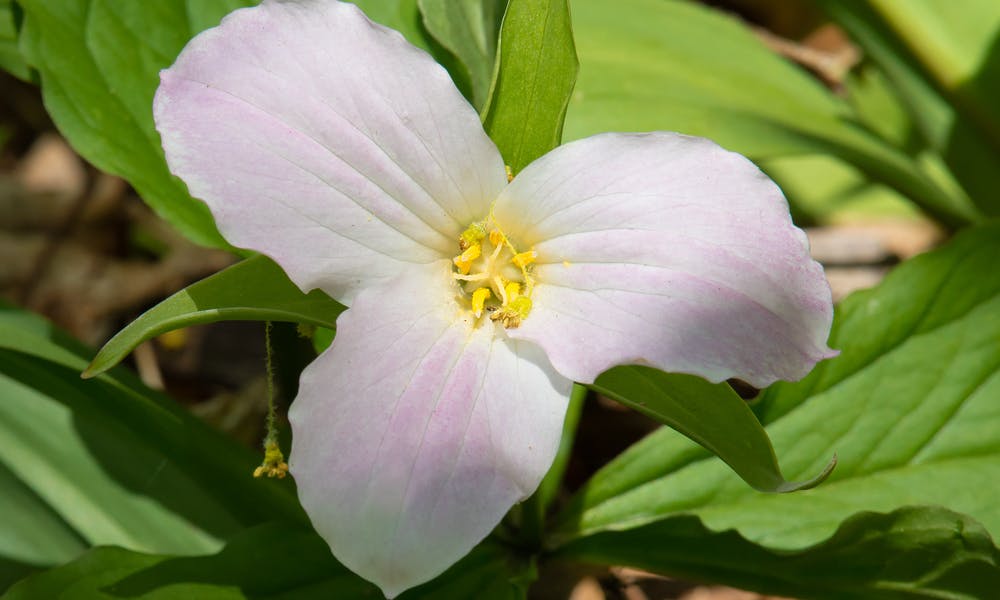MENU
Tried and True Trillium Flower

Captivating traditional names such as toad shade, wake-robin, and birthroot catch the intriguing values of the trillium flower. Sister to the lily, this flower’s petals loom in perfect symmetry with sleek lines, sure to catch the eye of anyone.
Trillium flowers are regions of North America and Asia. Considering there are over 40 species to choose from, trilliums can genuinely be a flower to accommodate everyone’s taste. These flowers are divided into two groups: sessile (flowering right upon the umbrella-like leaves) and pedicellate (flowering above the leave on a short stalk with a runway of stem in-between). Amongst nature lovers, wildflowers such as trilliums, are spoken to grow with wisdom in the petals because of their long blooming season. From appearance to growth, let us find out if the trillium is the flower for you.
Here are some things you can expect this article to mention about growing and caring for your trillium flowers.
- Features of the Flower
- Design Options
- Growing Tips
- Common Problems
Every flower is beautiful in signifying ways. Let’s see if trilliums are essential for your garden.
Features of the Flower
Trilliums, like most flowers, come in different colors to accent every garden differently. This flower is easy to grow from the roots but slows on the spread and development aspects. The blooming season of the trillium can vary between four and seven years. Although the flowering season is very lengthy, the good news is that their life span is expected to be between 20 to 25 years.
Trillium flowers are woodland species, meaning the plant is dormant and needs little sunlight. The most crucial time for this plant to get sun falls between early spring and mid-spring. This flower must be planted in an area that gets mild sun, then is shaded for a large portion of the day. Too much sun can slow down the blooming process and damage the stem.
The trillium flower also possesses an aroma of either sweet summer fruit or rotting meat left in the fridge for too long. The problem with knowing which species to plant to get the proper smell is that you can’t. The aroma is solely based on the blooming season outcome. This depends on how much sunlight, how much water, and how much frost the flower encounters.
Design Options
When considering adding trillium plants to your garden, there may be a few things you should acknowledge. Trillium flowers are not an aggressive species, and it is important not to plant them near seedling like flowers. Seedling flowers tend to overrun plants such as the trillium. Instead, maybe think of placing these flowers near shrubs, small trees, and bushes. Woodland species, such as the trillium flower, are found to strive when leaf litter mulch is the base of the garden. Be careful not to place too much; the leaf litter is a great tool to help regulate the temperature of the ground and the amount of moisture it holds near the base of the stems.
When using species like trillium flowers, the best design option is to replicate a forest home in your garden. This scheme is becoming more familiar with modern architecture. Another growing aspect with design layouts is the type of insects you prefer your garden to attract. The trillium flower’s aroma creates a diverse community of insects such as honeybees, bumblebees, and gnats.
Growing Tips
Coinciding with design options, other vital things to think about when creating a garden with trilliums is the type of soil this plant needs. The land is significant for plants to develop healthy and deep roots. Trillium flowers prefer soil with a high grade of organic matter, with a neutral to slightly acidic pH level. The reason for a high degree of organic matter is so the roots of the trillium flower receive the proper amount of water needed to grow.
Now that the ground is taken care of, it is time to discuss planting. When planting trilliums, they require division and the division being late summer to early fall. Knowingly these plants have a long blooming season, and they don’t require much sun until they have sprouted. The bulbs typically have thick outer edges. The thick edges give the plant everything it needs to last through the cold, harsh winters.
Common Problems
The appeal about trilliums is they have few problems, or people who have little experience with them will tell you. Some issues usually occur when we try to grow them in less than ideal conditions. Problems arise when gardeners over care for this plant. The flower is highly low maintenance and requires minimal attention once planted.
However, most of the problems that occur with growing trilliums are continually changing temperatures. Some people attempt to plant them in pots. Yes, they are capable of pot planting but do not strive in the restrictiveness of the walls. Containers have insulation properties that go among the needs of the trillium flower.
Lastly, trilliums attract one of the worst pests any gardener dreads to have, deer. Deer become very destructive when they spot a trillium flower.
Summary
All in all, the trillium flower, like most plants, have their ups and downs. Wildflowers tend to thrive in nature, and many people believe taking them out of their habitats is crucial to the species. This flower comes with many exciting features that are indeed unlike any other herb. Trillium flowers are not aggressive either, so when considering their presence in your garden, remember to plan accordingly. Trilliums are perfect for beginners that are looking to see if the possess the green thumb, due to not requiring much attention. Trilliums come with many quirks to their species, but it is just what makes them unique. Never rule out problems that occur with flowers, deer and other pests are sure to visit any garden that has appetizing trilliums.

